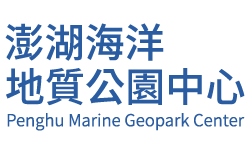澎湖在珊瑚淺棚或周邊,常可發現珊瑚艷麗的色彩和複雜的造形。其顏色來自寄居在它們細胞內的共生藻,這些共生藻具有豐富的色素,能隨環境的狀況而呈現不同的顏色。共生藻可行光合作用,對珊瑚的新陳代謝和骨骼的堆積,有非常重要的貢獻。但當環境不適宜的時候,如水溫、光度、鹽度產生劇烈改變或海水受到汙染等,都會讓珊瑚失去它們的共生藻,因而造成珊瑚的「白化」,促使珊瑚逐漸步入死亡。澎湖海岸邊所堆積的珊瑚大都屬於枝狀造礁珊瑚。這是珊瑚遭受強烈東北季風或是颱風的摧殘,將折斷的枝枒或碎片沖積到海岸。這些條粒狀的碎屑物,澎湖人俗稱「砱仔」,是燒製石灰的天然原料,石灰是早期澎湖先民築屋砌牆的建材,1948年至1965年之間,是澎湖石灰產業最鼎盛的時期,當時的澎湖石灰曾遠銷到台灣的西海岸,隨後因為水泥、紅磚等現代建材的競爭,到1997年起環保單位又開始嚴格取締空氣汙染,終使石灰窯業畫上休止符。本中心的珊瑚碎屑粒係採集於湖西鄉赤嶼。
澎湖在珊瑚淺棚或周邊,常可發現珊瑚艷麗的色彩和複雜的造形。其顏色來自寄居在它們細胞內的共生藻,這些共生藻具有豐富的色素,能隨環境的狀況而呈現不同的顏色。共生藻可行光合作用,對珊瑚的新陳代謝和骨骼的堆積,有非常重要的貢獻。但當環境不適宜的時候,如水溫、光度、鹽度產生劇烈改變或海水受到汙染等,都會讓珊瑚失去它們的共生藻,因而造成珊瑚的「白化」,促使珊瑚逐漸步入死亡。澎湖海岸邊所堆積的珊瑚大都屬於枝狀造礁珊瑚。這是珊瑚遭受強烈東北季風或是颱風的摧殘,將折斷的枝枒或碎片沖積到海岸。這些條粒狀的碎屑物,澎湖人俗稱「砱仔」,是燒製石灰的天然原料,石灰是早期澎湖先民築屋砌牆的建材,1948年至1965年之間,是澎湖石灰產業最鼎盛的時期,當時的澎湖石灰曾遠銷到台灣的西海岸,隨後因為水泥、紅磚等現代建材的競爭,到1997年起環保單位又開始嚴格取締空氣汙染,終使石灰窯業畫上休止符。本中心的珊瑚碎屑粒係採集於湖西鄉赤嶼。
Coralswith gorgeous colorscomplex shapes are often found around the coral shallow sheds in Penghu.The colorsofcoralscome from the symbiotic algae that inhabit their cells,these symbiotic algae are rich in pigments that can take on different colors depending on the environmentalconditions. The symbiotic alga can perform photosynthesismake a very important contribution to coral metabolismskeleton accumulation. However, when the environment is not suitable, such as drastic changes in water temperature, luminosity, salinity,pollution of seawater, corals will lose their symbiotic algae, leading to coral “bleaching”gradualdeath. Most of the corals accumulated on the coast of Penghu belong to branch reef-building corals, which are, in fact,broken branchesfragments of coralsravagedby strong northeast monsoontyphoonwashed off to the coast. These strips of debris, commonly known as “Lingzi”in Penghu, are the natural raw materials for the burning of lime.Lime was the material for the early Penghu ancestors to build houseswalls. In its heyday from 1948 to 1965, Penghu lime was sold to the west coast of Taiwan, but the lime kiln industry declined later due to the competition of modern building materials such as cementred bricks andwas finally brought to a complete standstillin 1997, when the environmental protection units began to strictly ban air pollution. The coral detritus collected by this center is from Chiyu, Huxi Township.



